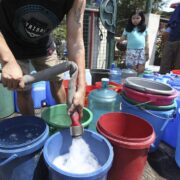How vulnerable is PH to the ‘Big One’?

The 7.7-magnitude earthquake that rocked Myanmar and Thailand on March 28 is a chilling reminder for everyone to start taking seriously the ever-present threats that come with living in the so-called “Pacific Ring of Fire.”
Within this horseshoe-shaped zone is a “string of underwater volcanoes and earthquake sites around the edges of the Pacific Ocean,” according to the National Oceanic and Atmospheric Administration (NOAA) Ocean Exploration Office.
NOAA explained that the Ring of Fire is the result of plate tectonics, saying, “Much of the volcanic activity occurs along subduction zones … [which] are also where Earth’s deepest ocean trenches are located and where deep earthquakes happen. The trenches form because as one plate subducts under another, it is bent downward. Earthquakes occur as the two plates scrape against each other and as the subducting plate bends.”
The Philippines is part of this Ring of Fire.
At 5:25 p.m. on April 1, a magnitude 5 earthquake struck Calatagan, Batangas, with the epicenter located 22 kilometers southwest of Calatagan and had a depth of focus of 133 km, according to an Inquirer report. It quoted the Philippine Institute of Volcanology and Seismology as saying that tectonic earthquakes are caused by sudden movement along faults and plate boundaries. Thankfully, there has been no reported damage, although aftershocks may occur.
Most at-risk country
These earthquakes, which we feel from time to time, are also a stark reminder that the Philippines remains the most at-risk country for extreme natural events and climatic threats. (“PH still world’s most at-risk to disasters,” Inquirer.net, 9/12/24)
According to the World Risk Report released in September 2024, for the third consecutive year, the Philippines remained number 1 with the highest risk (46.91 points). Indonesia followed in second place (41.13), India in third (40.96), Colombia in fourth (37.81), and Mexico in fifth.
The Index assesses the disaster risk for 193 United Nations member states, covering 99 percent of the global population. It measures these countries’ exposure to natural hazards or risks of experiencing disasters, or vulnerability to extreme natural events such as earthquakes, tsunamis, floods, and droughts. “The 2024 report highlights how crises like pandemics, extreme weather events, and conflict interact with and amplify one another, creating a complex web of risks that can overwhelm existing disaster risk management,” said the report, adding, “The report examines the global water crisis, the catastrophes-conflict nexus, and the effects of multiple crises on women’s mental health and well-being as case examples showing how an integrated approach to risk analysis and crisis management is needed.”

Earthquake readiness
Amidst all these dire reports, it’s worth asking whether the Philippines is prepared for the “Big One” hitting the country given its many major fault zones.
If you ask the Office of Civil Defense, its spokesperson Chris Bendijo would say that current government policies on earthquake preparedness are adequate. But the issue lies in their implementation, with the local government unit (LGU) always being the weakest link.
“We believe that our compliance needs to improve, such as in the issuance of building or occupancy permits, the LGUs need to make sure that the plans submitted conform with the building code,” he said in an interview with PTV’s Bagong Pilipinas Ngayon.
But Bendijo is correct in saying that the Philippines needs to catch up with its Southeast Asian neighbors in disaster preparedness. “We keep reminding our people about the other aspect of readiness—that is preparedness even before a disaster strikes—this is where we have a lot of catching up to do,” he said.
In addition to regular earthquake drills, LGUs should inspect and rigorously check if existing structures are in accordance with the standards set by the National Building Code.
He said that if strictly followed, the current metrics set by this code can ensure that private structures and government infrastructures can withstand strong earthquakes, including the projected “Big One,” estimated to be a magnitude 7.2, occurring in Metro Manila’s West Valley Fault.
“LGUs need to check whether the buildings are compliant to ensure their resilience. Our earthquake drills involving ‘duck, cover and hold’ will be useless if the buildings we are in collapse because they did not follow the building code,” he said.
But for us to become resilient, it’s wise to follow the World Risk Report and the United Nations Office for Disaster Risk Reduction’s (UNDRR) recommendation to adapt to evolving conditions, which is crucial to developing additional societal capacities.
According to the UNDRR, there must be alignment in the way we define risk, exposure, vulnerability, susceptibility, coping capacities, and adaptive capacities. As susceptibility can indicate the extent of our resilience and resources to mitigate the impacts of these extreme events, coping can counter these adverse impacts. But only through adaptive capacities can we have long-term strategies to mitigate these impacts, which include ample preparation and planning, and retrofitting of our buildings and infrastructure.
—————-
For comments: mubac@inquirer.com.ph


















